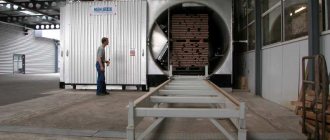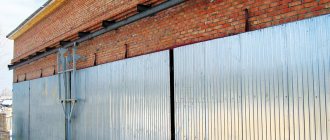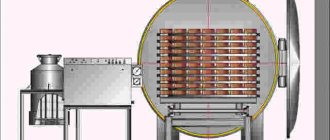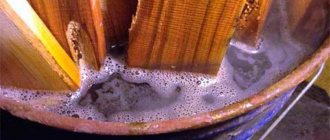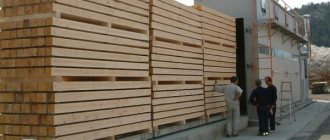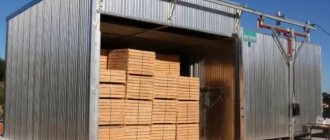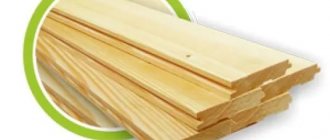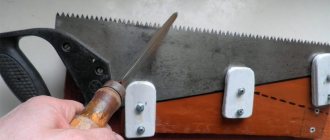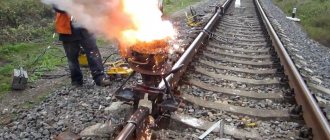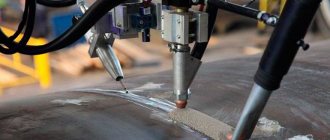The construction industry today is experiencing an active stage of technological development, which is reflected in the tools used, the methodology for performing repair and installation operations, and, of course, the materials. At the same time, due to availability and low cost, traditional materials, including wood, still remain in demand. Another thing is that it cannot be used in its pure form, since even solid rocks no longer meet construction standards in terms of protective properties. This barrier can be overcome by special preparation operations, including drying wood in drying chambers - a technology that improves a whole range of technical and physical characteristics of the material.
Chamber drying technology
The principle of drying in vacuum chambers is based on the laws of evaporation and water circulation. That is, the main objectives of the method come down to ensuring optimally rapid removal of moisture from the wood structure, but without negative consequences for performance. The technology under consideration is aimed at performing this process. In practice, it is carried out using special installations that ensure water circulation through the wood structure in the direction from the core to the outer part. Next, water is removed from the surface through evaporation. But it is important to understand that getting rid of moisture is not the only task that drying wood in drying chambers accomplishes. The technology also makes it possible to eliminate physical defects, but this requires additional equipment such as presses. As for the technical implementation of the process, it is usually performed by manually loading the material into the appropriate chamber. Then, due to the heating plates, the unit automatically warms up against the background of intense evaporation.
Vacuum drying of wood
Content
Technologies in wood processing do not stand still. More and more enterprises are moving into deep processing. This is where the question arises of choosing the most effective drying chamber.
This is necessary for this purpose in order to significantly improve the quality of lumber, increasing its strength, durability and endowing it with attractive appearance characteristics. But not every drying chamber meets the requirements of modern enterprises. With some types of chambers, only 20-30% of moisture is removed from the wood.
And this does not fit into the framework of the concept of high-quality lumber, especially when it comes to carpentry and moldings.
To select the right equipment for drying wood, you must be guided, first of all, by the customer’s requirements and the initial condition of the lumber.
Advantages of vacuum drying chambers
If it was cut at a humidity of 90%, then the distributed humidity will be quite high, so drying will take a lot of time if you use traditional type chambers. All systems with air blowing take a relatively long time to remove moisture, and the lumber often twists and warps heavily.
To obtain high-quality lumber, vacuum drying chambers are increasingly being chosen. These chambers differ in heating method into 2 types: contact and convective. The contact method allows you to heat the stack to its full depth evenly along its entire length. This is achieved through the use of special heating panels. This method allows you to obtain high-quality lumber in a shorter period of time.
The convective method is also good for vacuum drying wood. The main advantage of the process is in a vacuum, due to which moisture is literally sucked out from the depths of the wood. Vacuum drying of wood allows you to more efficiently and quickly remove moisture to any percentage. Humidity 6-8% is often achieved within 3 days. And mobility, versatility and ease of operation are an ideal addition.
This vacuum dryer is also an excellent source of thermal energy. Recycled heat can be used to heat production and storage facilities in winter.
This will allow you to significantly save on energy costs. In addition, this vacuum drying technology allows you to save on the wood drying process, because when connecting a boiler using industrial waste, the electricity consumption is about 1.5 kW/hour.
Features of the vacuum drying method
Compared to traditional drying chambers, new cylindrical vacuum drying technologies allow for a high process speed. This is connected not so much with the principle of influence on the material, but with the mechanics of loading and the location of the workpieces relative to the functional plates. But the thermal effect also has its own characteristics. Since the wood material is compressed between the plates under pressure, a high intensity of impact on the structure is ensured - accordingly, more moisture is evaporated. In terms of energy consumption, vacuum drying of wood also has its differences. Features of the technology in this parameter are determined by increasing the temperature of the plates and optimizing the physical movement of the material inside the chamber. Therefore, to achieve the same results as alternative drying methods, such chambers consume less energy.
How wood is dried
Vacuum drying of wood is carried out in 3 stages.
These include:
- Elementary. Surface processing of lumber is carried out here. Drying is carried out by heating without using a vacuum. The temperature inside the chamber is selected individually, taking into account the type of wood and its thickness;
- Drying. A special pump is used here, which allows you to quickly remove air masses from a closed space. Thanks to this, it is possible to evenly distribute moisture inside the wood fibers. The vacuum pump prevents deformation and cracking of the internal contents. Excess liquid quickly evaporates or is removed through special channels;
- Conditioning. In this case, the boards begin to cool evenly. In this way they manage to convey strength and endurance. The conditioning stages reduce the risk of deformation. After cooling, the lumber is carefully removed from the vacuum container.
You can monitor the performance of the device using special sensors and a control panel on the equipment body. In this way, it is possible to maintain the performance characteristics of the boards.
It is first recommended to correctly set the pressure level, which will affect the condition of wooden products. For example, to dry oak whose thickness exceeds 30 mm, select a temperature of at least 85 degrees.
The pressure volume should be no more than 520 kg per 1 sq. m. Lumber from this wood will be dried for 30 days.
Drying stages
Automated cameras allow you to implement a standard set of technological steps without user intervention, which looks like this:
- Warming up the material. Primary heat treatment, during which the wood structure is prepared for subsequent stages.
- Direct drying. At this stage, a combined moistening-drying operation is performed, which allows the material to be softened as much as possible for further drying.
- Cooling. In essence, this is the stage of crystallization of the structure, thanks to which the wood, which has become pliable due to heat treatment, regains its optimal hardness characteristics.
As noted above, all stages of the drying process are controlled automatically, and the operator monitors the safety indicators. But even before the start of the event, the user is required to set the optimal drying mode. In particular, it sets pressure and temperature based on the characteristics of the material. For example, for coniferous blanks with a thickness of 2.5 cm, a pressure of 500 kg/m2 is required. As for the temperature, in this case it can be 80 °C.
Vacuum drying of vegetables and fruits
Vacuum drying is the action of sublimation or lyophilization, which is based on a technological process that has been productively used for many years, as well as in the food industry and in the pharmaceutical field. As for the latter, in this case, the use of vacuum drying is important for the production of elements and goods that are highly susceptible to heat: vaccines, pharmaceuticals, biotechnological products, food products for people with a narrow dietary menu, and much more.
The technological characteristic features of vacuum drying are determined by the high speed of movement, the absolute absence of air molecules, a low degree of temperature, which together guarantees structural unity and preserves the main characteristics of the material (shape, smells, colors, food properties, structure, bio-dynamism, caloric value, necessary vitamins and minerals).
At its core, vacuum freeze drying is a period in which dehydration is performed. The provided process is that pre-frozen products are placed in a vacuum environment, where they are heated. Due to the fact that the product, being in the solid phase, in the form of ice, begins to sublimate, that is, ice, due to being in a vacuum, is instantly transferred from the solid phase to the gaseous phase, absolutely bypassing the separation of water.
The entire process of vacuum drying can be divided into 3 main stages, which determine the method of processing the cultivated material:
- The first stage involves freezing until it is as hard as possible. To ensure proper freezing, a triple phase pressure of 4.58 mm Hg is applied. Art., at zero temperature.
- The second stage involves the primary sublimation of the solid form of water. Conditions have been created inside the working chamber so that the vacuum environment has a pressure below the compression ratio of ice vapor. The unit turns on heaters that heat the material being processed and cause water vapor to appear on the surface of the product and then collect in the condenser. After ice crystals come out of the inner fibers of the food, microcavities remain there.
- The last, third stage is called secondary drying, during which residual liquid is removed from the surface layer of the processed product. This process is called desorption and is carried out by increasing the temperature and decreasing the degree of vapor pressure inside the working volume of the chamber.
Since the days before vacuum drying chambers were invented, traditional methods have been used to remove moisture from food using conventional heat. But with such thermal exposure, coagulation of the protein mass inevitably occurs, which is due to an impressive loss of nutrients inside the product. In our time, such methods of dehydrating food elements are still used, but every year vacuum freeze-drying is increasingly replacing outdated methods, since it has tens of times more privileges and advantages that allow preserving not only the beneficial properties of products, but also their shape, structure, as well as taste.
For example, we can cite the results of one scientific study, the purpose of which was to test fruits and vegetables (red peppers, strawberries, oranges, limes, currants, broccoli) for the amount of preserved proteins and nutrients after freeze-driing vacuum drying. The final results of the dried strawberries were 100% vitamin C and final components, provided that the total loss of antioxidant capacity was only 8%. If we compare these data with the results of laboratory tests taken from strawberries that were refrigerated for 7 days, then vitamin C will decrease by 20%, and the total antioxidant capacity will drop to 23%.
In addition to the tests described above, interesting tests were carried out by the Newcastle and Chaucer Agricultural Institutes on how much vitamin C loss would occur in vacuum freeze-dried products after one year of storage. For clarity, let’s look at strawberries. Samples for vitamin C levels were taken quarterly throughout the year, and what is most interesting is the miniscule level of loss, expressed at 1.8% per month.
As you can see, the technological process of vacuum drying makes it possible to preserve products, maximizing their quality and characteristics over a long shelf life, which cannot be achieved using traditional methods of dehydrating food.
Drying chamber device
Modern cameras are made in the form of a parallelepiped or cylinder. The output side of the structure is equipped with a lid, through which material loading/unloading operations are carried out. Moreover, the structure of the lid includes a rubber sheet fixed on a metal frame - this solution allows you to create an almost perfect vacuum with increased sealing. Each layer of lumber is lined with heating plates, which are usually made of thermally conductive aluminum alloys. To carry out movements, the plates are equipped with roller mechanisms. The movement of the heaters ensures balanced drying of the wood in the drying chambers. The chamber manufacturing technology also provides for the connection of circuits with circulating water. Boilers with liquid are located separately and provide their own heating. To maintain a stable vacuum, a special pump is placed inside the chamber.
Application of hydraulic press
It has already been said above that during the drying stages, the structure of the wood softens and becomes pliable. This condition is a side effect and redundant within the drying process. Actually, to eliminate these consequences, the final cooling stage is provided. However, the softened structure of the material can be exposed to a hydraulic press, which will rid the workpiece of physical defects - at least ensure its straightening. Such presses are included in the general complex of capacities at which wood is dried in drying chambers. The pressing technology, in turn, eliminates possible defects that were acquired by the material in the chamber. The final workpiece will be “correctly” deformed with the parameters needed for working lumber.
Technological modes of vacuum drying of lumber using convective methods of heat supply
Safin R.R.
In recent years, Russia has seen the growth of small and medium-sized enterprises producing joinery, construction products and furniture, consuming lumber and blanks from coniferous, deciduous and, especially, hardwood. Such industries, which produce products according to European standards, required high-quality wood drying. The emerging demand for high-quality and at the same time short-term drying has led to an increase in the supply of vacuum chambers on the drying equipment market. The use of vacuum technologies makes it possible to obtain an economic effect when drying expensive hardwood, not only by reducing the duration of the process, but also by lowering the drying temperature, which, in addition, reduces the destruction of wood and does not affect color changes.
However, when implementing vacuum methods, significant difficulties arise in supplying heat under low pressure conditions. Known methods of supplying heat in a vacuum are expensive (High-frequency and microwave energy) or are characterized by a labor-intensive process and unsatisfactory quality (contact methods). Therefore, researchers consider methods using convective heat supply to be the most promising in the field of vacuum drying of wood.
The currently existing technological modes for vacuum drying of lumber with convective energy supply were mainly obtained by device developers purely empirically and are distinguished by great diversity. Each of these modes has its own advantages and disadvantages over its analogues, and therefore is most often focused on a specific range of lumber.
The entire wide range of vacuum technologies for drying wood with the supply of thermal energy by convection can be classified as follows:
- “pulse” technologies, the drying process in which consists of successively alternating stages of heating the lumber and vacuuming;
- convective drying of lumber at low pressure;
- drying wood in liquids above the surface of which the pressure is lower than atmospheric.
Let's consider the main technological features of the presented classes.
The essence of “pulse” technologies is to carry out the drying process cyclically. At the first stage of the cycle (the so-called “impulse” stage), thermal energy is transferred to the material, which will subsequently be the driving force behind the moisture removal process. At the heating stage, the material is blown with a hot coolant at a medium pressure equal to or close to atmospheric. During this period, the temperature of the wood rises, which is accompanied by the evaporation of moisture from its surface. Humidity decreases slightly. The movement of moisture inside the material occurs under the influence of a humidity gradient. The “impulse” stage lasts until the wood in the center is heated to a temperature exceeding the boiling point of water at reduced pressure at the vacuum stage.
At the second stage (vacuum stage), intensive evaporation of moisture from the surface of the material begins. The surface temperature decreases, quickly reaches the boiling point, and then continues to fall. Water boils in the cell cavities, and the resulting water vapor moves to the surface under excess pressure. In this case, part of the steam is removed from the wood, and part, upon contact with cooled surface zones, condenses. The water vapor that leaves the wood forms an environment of almost pure saturated or superheated steam around it. As a result of this, moisture is removed with a sufficiently high surface humidity and, therefore, a small difference across the thickness of the material, which avoids significant drying stresses and large residual deformations.
During the period of holding the boards in a vacuum when free moisture is removed, its movement occurs under the influence of pressure, humidity and temperature gradients, and when the wood moisture content is below the saturation limit - humidity and temperature gradients. This ensures the high intensity of vacuum drying. Vacuuming stops after the temperature in the center of the material drops below the boiling point of water at a given vacuum depth.
Among the “pulse” technologies, the most widespread is the vacuum-convective drying method, where hot air is used at the stage of heating the material. This method has proven itself well when drying oak lumber. However, in production conditions it was often difficult to regulate the operating parameters of hot air.
Since it is known that removing moisture from wood during its heating process often leads to a violation of the integrity of the surface layers, the wood must be quickly heated without evaporating moisture from it, for which a high degree of saturation of the environment must be created in the chamber. The degree of saturation when the wood moisture content is above 25% is set in the range of 0.98 - 1, and when the wood moisture content is below 25% - 0.90 - 0.92. Thus, the use of hot air at the wood heating stage is only possible in combination with saturated steam. Otherwise, a decrease in the quality of lumber may occur.
Therefore, the development of the vacuum-convective method was the technology of vacuum-oscillating drying of lumber, developed by employees of the Department of Wood Materials Processing of KSTU, in which the wood is heated in an environment of superheated steam in the absence of air in the cavity of the apparatus. Preliminary removal of air from the vacuum chamber leads to the absence of phase resistance (the technology is inherently close to the “heat pipe” system), thereby promoting more intense heating of the lumber. The warm-up stage consists of two periods (see Fig. 1):
- heating the surface layers of the material due to steam condensation;
- general heating of wood in an environment of superheated steam.
The use of superheated steam for heating is also advisable from the point of view of relaxation of internal stresses that arose at the previous stage of evacuation, since at the beginning of the heating stage, the steam condensing on the cold surface of the material acts as an intermediate heat and moisture treatment. The proposed technology simplifies process control and allows for faster drying by reducing the duration of the heating stage.
One of the varieties of “pulse” technology is wood drying by “pressure release”. The physical basis of this method is the maximum use of the effect of intense molar transfer of steam that occurs after preheating wet lumber under pressure and its subsequent rapid reduction to a pressure below atmospheric; for this purpose, a vacuum receiver is used. At the moment of “relief” of pressure, rapid boiling of moisture occurs throughout the entire volume of the body; a pressure difference is formed between the center and the surface of the sample, facilitating the formation of a flow of moisture in the form of steam directed towards the surface of the particle. On its way, the steam flow carries away liquid droplets, and when it encounters solid water plugs, it pushes them towards the surface of the sample. By regulating the boiling process, that is, the rate at which the pressure of the medium decreases, it is possible to ensure that up to 40% of moisture in liquid form is removed from the material along with steam (an effect similar to mechanical dehydration).
However, with a sudden “release” of pressure, there is a danger of destruction or modification of the structure of the lumber, therefore, when removing moisture using this method, an individual approach to drying each batch of material is necessary. In addition, the need to create a vacuum receiver that allows the “relief” of pressure below atmospheric pressure and is comparable in size to the direct drying vacuum chamber leads to a significant increase in the cost of the entire drying installation.
Convective drying of lumber at low pressure is a special case of traditional convective technology and can also be carried out in an environment of hot air and superheated steam. The main technological difference of this method is that drying occurs in a rarefied environment, which makes it possible to use lower temperature conditions.
There are several technological schemes for convective drying in a rarefied environment: in combination with “pulse” technology in the range of a certain wood moisture content or as an independent drying method. As an independent method of removing moisture, this method is used mainly for drying soft wood, when the use of “pulse” technologies is impractical due to complex technological regulations.
One of the possible technological modes, proposed by KSTU employees and presented in Fig. 2, provides for heating lumber at atmospheric pressure, a drying stage at decreasing environmental pressure, drying at a constant residual pressure and when the average wood moisture content decreases below 20% - drying at a controlled increase in pressure depending on the moisture content of the wood.
There is also a known scheme developed by the staff of Moscow State University of Forestry, according to which the process is carried out in a vacuum with a depth of 0.085 - 0.090 MPa with convection of the drying agent at a speed of 15 - 20 m/s. Drying is carried out in “work-pause” cycles at a constant vacuum depth. At the “work” stage, drying occurs in an environment whose temperature is higher than the boiling point of water at a given pressure. This stage is characterized by a high intensity of the process due to a large moisture gradient across the thickness of the material. Due to the short duration, the resulting drying stresses are relatively small, and the deformations are mainly elastic in nature. At the “pause” stage, the circulation system is turned off and the humidity is equalized across the thickness of the material and the drying stresses are reduced. The decrease in the moisture gradient is compensated by the positive temperature gradient that arises in the material due to the decrease in surface temperature, so the speed of moisture movement in the wood remains at the same level.
The duration of the “work” stage is determined by the drying stresses that arise, which should not exceed the elastic limit. At the “pause” stage, the duration is set based on the condition of equalizing the temperature of the center and surface and stopping the movement of moisture under the influence of the temperature gradient.
This method of vacuum drying, according to the developers, dramatically increases the service life of the vacuum pump and reduces its energy consumption.
Vacuum drying of wood in liquids is a special case of drying in hydrophobic liquids and is called combined drying-impregnation, since antiseptic impregnating oils are used as a drying agent, and after removing moisture from the wood, pressure impregnation is carried out.
The main type of moisture transfer in this case is the molar movement of steam under the influence of an excess pressure gradient inside the material, therefore, removal of moisture from wood is possible only at a liquid temperature above the boiling point of water at a given pressure.
Under conditions of vacuum drying of wood with heat supplied from a liquid coolant above the surface of the material, there is no barometric pressure, so moisture is removed from the material at a liquid temperature above the boiling point of water at the pressure of a column of hydrophobic liquid. This process scheme makes it possible to reduce the temperature of the medium to 80–90 °C, which is significantly lower compared to traditional drying in liquids, where the temperature is maintained in the range of 120–130 °C. Thus, vacuum drying of wood in liquids makes it possible to prevent the occurrence of a significant difference in humidity across the cross section of the wood, and hence the development of destructive drying stresses.
This method is used for processing sleepers and other large-sized assortments for which there are no requirements for appearance.
All articles
Drying methods
At the moment of technology development, there are three main methods of vacuum drying. The first two methods have already been discussed - direct drying and press-vacuum preparation of the material. But there is also a method of steam treatment in a vacuum chamber. Its relevance is due to the possibility of eliminating heating plates from the chamber design, since hot steam covers the entire space, without requiring special direction of flows to individual sections of the workpiece. This approach provides many advantages that steam heating methods of wood drying provide. Drying chambers, for example, allow loading not only by labor-intensive manual methods, but also by using forklifts.
Press vacuum drying chamber. Price
Speaking about the use of such cameras, we can safely say that they are in greatest demand in Moscow. Although, you can buy vacuum drying chambers in any other city, and much cheaper. In the capital, the price is determined by the great demand for such equipment. Much in determining the cost depends on which particular variation of vacuum presses we are talking about.
Press vacuum drying chamber. Price
Now we will look at the variations of vacuum drying chambers that are in great demand:
- Convection drying chambers
- Vacuum drying chambers
- Aerodynamic chambers
- Dielectric drying chambers
- Microwave drying chambers
The operating principle of the above cameras differs from each other in many ways, and accordingly, their cost can be completely different. That is why, even before purchasing, you should decide on the camera variation that you need. You should also determine the appropriate price segment in which you can afford to purchase some kind of vacuum dryer.
Now we will look at the price ranges of PVSK vacuum drying chambers:
- Low price segment of the market – 90,000 rubles to 150,000 rubles
- The average price segment of the market is from 150,000 rubles to 300,000 rubles
- High price segment of the market - from 300,000 rubles to 850,000 rubles and above
Based on the price range, you can easily understand how high-quality and versatile the installation will be in use. When purchasing drying chambers for yourself, you need to pay attention to the cost and not buy the first unit you come across. It is advisable to give preference to cameras from the middle range, or low, but as close as possible to the average. In this way, it will be possible to avoid not entirely conscientious manufacturers who create cheap and low-quality equipment in order to earn as much as possible from it.
What effect does drying provide?
Drying itself, as a process of optimizing the hygroscopic properties, gives the wood relatively high strength indicators. This is already enough for the material to meet the basic requirements of building regulations. But large wood processing plants use the above-described technologies and methods of drying wood only as a preparatory stage for further processing of the material. In particular, for impregnations, which will additionally give the workpieces the qualities of fire resistance, moisture resistance, frost resistance, etc.
| Drum dryers |
| Dryers with an inclined drum rotating around a horizontal axis |
| Rotary conical dryers |
| All pages |
Drying cabinets
. The simplest in design are dryers with a fixed layer of dried material. These are vacuum drying ovens of cylindrical or rectangular shape, heated by steam, and in rare cases hot water, with barometric or surface condensers or with wet-air pumps. Surface condensers are used if it is necessary to capture vapors of valuable volatile solvents; If the solvent is water, then vacuum cabinets are usually equipped with barometric mixing condensers.
The study of the process of vacuum drying in a fixed bed and experience in operating vacuum drying ovens show that this drying method is ineffective. In addition, the manual labor costs are very high, since the loading and unloading of cabinets is done manually. Such cabinets are used only in installations with low productivity. Dryers in which the material can be mixed during drying are more productive.
Row dryers are devices in which a shaft with blades, called combs, rotates inside, mixing the material to be dried. Thanks to mixing, the final product in them is obtained in a coarsely crushed form (in the form of cereals). For heating, there is a jacket of the apparatus body, into which steam or hot water is supplied, a hollow shaft, into which the coolant is supplied, and, finally, both the shaft and the jacket at the same time. The most common for drying pasty materials are rake vacuum dryers with periodic changes in the direction of shaft rotation.
Domestic-made rake dryers (vacuum cylindrical dryers with a reversible mixer) have the following technical characteristics (V—full geometric capacity; D and L are indicated in Fig. 72)
SVTSR 800/2500 SVTSR 1000/3200 SVTSR 1250/4000
D in mm 800 1000 1 250
L in mm 2500 3200 4 000
V in l 1320 2600 5 040
Weight in kg 5000 7200 11 300
A study of the operation of a rake vacuum dryer showed that the progress of the drying process depends on the initial moisture content of the material. The process at high initial humidity consists of two stages. In the first stage, there is a period of heating, constant and decreasing drying speed. In the second stage (at a humidity of 34-35%), the drying speed again increases greatly and exceeds the maximum speed of the first stage, and then drops again. This is explained by the fact that when the paste dries to a moisture content of 34-35%, it easily crumbles into small pieces under the action of a stirrer. This significantly increases the evaporation surface and increases the drying rate.
In Fig. Figure 73 shows a rake dryer from Buss (Switzerland, the dryer diagram and approximate overall dimensions of various types of such dryers are shown in Figure 74 and Table 24.
Parts of the apparatus that come into contact with the material being dried are made of chromium-nickel steel. The material to be dried can be liquid, paste or solid (coarse or fine grain). If water is removed from the product, then the operating pressure in the dryer is 30-40 mmHg. Art., and in
in some cases even lower. In this case, the temperature of the material being dried does not exceed 100° C. Thus, drying occurs at low temperatures, and the device can be used for materials sensitive to high temperatures.
Table 24 Parameter values for nominal capacity in l
Since the material being dried is continuously moving inside the dryer, its temperature can be higher than the stationary material (all other things being equal). The large temperature difference between the coolant and the material being dried, as well as constant mixing and grinding, significantly reduces the drying time.
Rice. 74. Diagram and overall dimensions of a rake dryer from Buss (Switzerland): 1 - dryer; 2 - transmission mechanism; 3 - bag filter; 4 - intermediate part; 5—unloading device; 6 - filling pipe
A mixer with blades rotates in a horizontal cylindrical body of the dryer. The dryer shell and the agitator shaft with blades can be heated.
Table 25
| Diameter B mm | Length in mm | Capacity in l | Heat transfer surface in M1 | Diameter B mm | Length in mm | Capacity in l | Heat transfer surface in m |
| 600 | 2500 | 700 | 4,71 | 1200 | 4500 | 5 100 | 17,0 |
| 600 | 4000 | 1140 | 7,55 | 1200 | 6000 | 6 800 | 22,6 |
| 800 | 3000 | 1500 | 7,55 | 1200 | 7500 | 8 500 | 28,2 |
| 800 | 4000 | 2000 | 10,0 | 1500 | 4500 | 9 000 | 22,6 |
| 950 | 3000 | 2120 | 8,95 | 1500 | 6000 | 12 000 | 30,1 |
| 950 | 4500 | 3190 | 13;4 | 1500 | 7500 | 15 000 | 37,7 |
| 950 | 6000 | 4250 | 17,9 | 1500 | 9000 | 18 000 | 45,1 |
Heating is carried out with steam, and in some cases with a liquid coolant - hot water. Saturated steam for heating has a pressure of 5 atm. Liquid coolant is used in cases where the heating temperature must be significantly below 100° C. The stirrer bearings are located outside the housing and do not come into contact with the material being dried. The design of the shaft and housing allows drying very viscous products.
Loading and unloading of the dryer is largely mechanized. The steam released from the product being dried passes through a special heated filter and then enters the condenser. For water vapor, an injection-type capacitor is usually used; if it is necessary to capture the vapor of a valuable or toxic material, then a surface-type capacitor is used. A water ring vacuum pump is used to pump out non-condensable gases. Dryers fill to approximately 50% of their capacity.
The diagram of the GDR dryer (Deitsche vacuum apparatus) is shown in Fig. 76. Dryers of this type with a heating surface from 32 to 150 m2 are designed for heavy loads. For work at pressures greater than 17.5 mmHg. Art. They produce dryers of smaller sizes with heating surfaces from 4.3 to 21 m2.
Tray dryers are a type of dryer with an agitator. The material is located at the bottom of the apparatus, equipped with a heating jacket, and is mixed by blades mounted on a rotating shaft (Fig. 77).
Table 26
| Dryer capacity in l | Inner diameter in m | Height in m | Weight in kg |
| 189 | 0,91 | 0,3 | 1580 |
| 1140 | 1,83 | 0,46 | 4930 |
| 1670 | 1,83 | 0,66 | 5750 |
| 1900 | 2,0 | 0,61 | 4550 |
To speed up drying, you can heat the body and lid, then heat is transferred to the material not only by thermal conductivity, but also by thermal radiation. Dryers are usually used to dry small quantities of highly dusty materials. In some cases, when loading the dryer, wet material is mixed with pre-dried material.
Diagrams of plate dryers of various designs are shown in Fig. 78. Technical characteristics of single-deck plate dryers from Buflovak (USA) are given in table. 26.
The drum vacuum dryer consists of a cylindrical vacuum body with a heating jacket, rotating around a horizontal axis, and a fitting with a lid and hatch, which serves for loading and unloading material when the drum is small. The steam-air mixture exits through the load-bearing axle of the front wall of the hull, and the coolant circulates through another axle to heat the hull jacket. In addition, lifting blades are sometimes mounted on the inner wall of the drum, which, in one direction of rotation, load the material, and in the opposite direction, move the material towards the unloading hole.
Many drum dryers have a complex internal arrangement for additional heating of the material (tubular or coil heating system). An example is the VSAI dryer with domestically produced tubular heaters (Fig. 79). The dryer is designed for drying polyamide crumbs of nylon resin. The use of a drum dryer allows drying with continuous stirring, which ensures uniform moisture content of the resin and eliminates the possibility of burning. In addition, in a vacuum, the oxygen concentration in the drum decreases by about 100 times, so the properties of the resin do not deteriorate.
The drum rotates from an electric motor through a V-belt drive, a worm gearbox and a cylindrical pair. The rotation speed of the drum is regulated by changing the V-belt pulleys. A wet dust collector (a vertical cylindrical vessel with welded bottoms) is designed to clean the steam-air mixture from polyamide resin dust.
Rice. 79. Drum vacuum dryer type BCA with tubular heaters: 1 - hatch for loading and unloading Du-400; 2 — device for sampling; 3 — tubes to pressure and vacuum gauges; 4 - steam inlet; 5 — condensate outlet; 6 — air vent; 7 — collection of nylon dust; 8 — air intake; 9—to the piston vacuum pump; 10—suction of water vapor; 11 - to thermometer 1
Condensers serve to condense water and lactam vapor. The lactam solution is regenerated.
Vacuum drum dryers of the Irkutsk branch of NIIHIMMASH have a one-time drum loading of 0.015 to 0.045 m3. The drums are heated with water steam or liquid dinyl. In addition, a dryer with a one-time load of 0.32 m3 and heated with water steam is produced. The vacuum in the dryer is created either by a steam ejector pump or by a VN-4G rotary oil pump. When the VN-4G pump is operating, the circuit includes a dust separator, a surface condenser, and a freeze-out condenser to capture residual moisture.
It is most rational to work with a steam ejector pump if there is production steam with a pressure of 0.6 Mn/mg and the building height is sufficient to install barometric pipes. During drying, the material continuously moves along the periphery of the outer and inner drying drums. Loading and unloading of the product is carried out by a screw located in the loading trunnion and a scroll on the end wall on the loading and unloading side.
The dried material is fed into the loading hopper through a special hatch, after which the hatch is closed and a vacuum is created in the system. After equalizing the pressures in the loading hopper and the dryer body, the hopper valve opens, the drum drive is turned on, and coolant is supplied to the drum jackets. To create a mild temperature regime during the period of loading the product into the dryer when heated with water steam, a vortex pump is turned on to create a vacuum in the drum jackets. The rate of product supply to the dryer is controlled by the opening value of the loading hopper valve. There are two options for connecting a drum dryer; with a steam ejector pump and with a mechanical one (Fig. 80 and 81). Technical characteristics of dryers are given in table. 27.
Table 27
| Options | Parameter values for drying units with loading in m3 | |||
| 0.015 | 0,032 | 0,045 | 0,32 | |
| Total capacity in m3…… | 0,037 | 0,075 | 0,104 | 0,7 |
| Fill factor. | 0,4 | 0,45 | 0,45 | 0,45 |
| Heating surface in m2 | 0,74 | 1,22 | 1,6 | 4,88 |
| Heating………….. | Water vapor or liquid dinyl | water vapor | ||
| Drum angular speed | 1,26 | 1,26 | 1.05 | 1,84 |
| Drive power in kW….. | 0,6 | 0,6 | 1,7 | 1,7 |
| Overall dimensions of the dryer drum in mm: | ||||
| diameter……. | 300 | 350 | 400 | 800 |
| height | 645 | 700 | 920 | 1400 |
| Overall dimensions of the dryer in mm: | ||||
| height ………… | 740 | 730 | 80 | 1340 |
| Dryer weight in kg…….. | 301 | 340 | 496 | 1700 |
Note. Maximum initial humidity 15%; minimum final humidity 0.01 - 0.02%; surface moisture stress in the 1st drying period is 1.25 kg/(m2*h), in the 2nd - 0.28 kg/(m'-h); residual pressure in the drum 6.6-10* MN/m2; steam pressure in the jacket up to 0.2 MN/m2; temperature of the heating surface when heated by air up to 533° K and with steam up to 388° K
Rice. 80. Schematic diagram of a vacuum drum drying unit with a steam ejector pump: 1 - vacuum drum dryer; 2 - loading hopper; 3 — steam ejector vacuum pump; 4 — barometric box; 5 - refrigerator; 6 - pump; 7 - descent into the sewer; 8 — unloading crumbs; 9 — condensate drain; 10—steam inlet; 11 - V - ejector stages
Fig. 81. Schematic diagram of a vacuum drum drying unit with a mechanical pump: I - vacuum drum dryer; 2 - loading hopper; 3 — condenser from the drying unit; 4 — vacuum pump VN-4G; 5 - dust collector; 6 — freezing capacitor; 7 - refrigerator; 8 — descent into the sewer; 9 — entrance; 10 — condensate drain; 11 — steam inlet;
The company Deitsche Vacuum Apparatus (GDR) produces vacuum drum dryers of various sizes. In Fig. 82 shows a dryer in which the process occurs at a pressure of -0.5 mm Hg. Art. Although the pressure inside the apparatus is lower than the triple point pressure of water, the amount of heat input is high enough to ensure thermal drying without freezing the material. Steam and non-condensable gases are sucked out of the dryer by steam ejector multistage pumps. A batch drying unit with a daily capacity of 3.7 tons of finished product (per load) for drying polyamide crumbs from an initial moisture content of 12% to a moisture content of 0.05% consists of a raw material hopper with a capacity of 6 m3, a rotating drum with a diameter of 2000 mm and a length of 4000 mm and an unloading cooling device.
The drum is a horizontal cylinder with a jacket, inside of which three more double-walled heated cylinders are concentrically built. Fastening is done with special spacers. Conveyor screws welded between the cylinders create circulation of material in the apparatus both along the axis and in the radial direction. Wet material is loaded through pipe 13 and spirally—conveyor screw 11—it enters the drum.
Along the inner cylinder, the substance moves from left to right, after which it enters the next annular space, passes through it from right to left, etc. Finally, having passed through the outer annular space, it, using a special device, enters the inner cylinder and repeats the same circulation circuit. After drying is completed, the direction of rotation of the drum is reversed, and the substance is removed from the dryer by screw 11. On both sides of the drum there are heated covers with hollow pins. Thus, loading and unloading is carried out on one side of the dryer using a screw device located on the inside of the lid. The screw rotates along with the drum.
Drying is carried out as follows. A vacuum is created in the drum and at the same time the drum is heated by passing so-called vacuum steam into the steam jackets, i.e. steam with a pressure below atmospheric. The raw product is loaded into a hopper and a vacuum is created in it using a wet-air pump. When the pressure in the hopper equals the pressure inside the drum, the material is poured through the downpipe and into the drum loading auger. After loading is completed, the dryer is switched to full heating, i.e., an excess pressure of a maximum of 1 atm is created in the steam system. Condensate is sucked out of the jacket by a separate wet-air pump. A cyclone is installed to collect dust.
Preliminary pumping of air from the drum is carried out by a wet-air vacuum pump. When the pressure in the dryer after loading reaches 20 mmHg. Art. (the maximum pressure created by the wet-air pump), three stages of the steam ejector pump are switched on in turn. Drying temperature 90° C, residual pressure in the dryer 0.5 mm Hg. Art.
After drying is completed, as evidenced by an increase in the temperature of the material, a vacuum is created in the unloading refrigerated hopper. The unloading hopper consists of a cylinder and a conical bottom with a cooling jacket - water cooling at 15 ° C. Inside there is another cylinder with a jacket of small diameter, inside which a screw rotates at a speed of 60 rpm. In the annular space between the outer and inner cylinders, blades for transporting material are welded to both walls.
Rice. 82. Drum vacuum dryer with concentric steam jackets (Deutsche vacuum apparatus company, GDR): 1 - steam inlet; 2 - drive; 3 - bearing; 4 - axle; 5 — heated front cover; 6 - concentric heated drums; 7 - heated outer casing; 8 — hatch; 9 — hollow trunnion; 10 — screw body; 11 — conveyor screw; 12 - outlet of steam-air mixture; 13 — pipe for loading wet material; 14 - electric motor; 15 - vacuum seal; 16 - unloading dry material
Before unloading begins, I change the direction of rotation of the drum to the opposite and increase its rotation speed. The material coming from the dryer fills the conical bottom of the unloading hopper, then it is picked up by a vertical auger, passes upward and is poured into the outer annular chamber. This ensures constant circulation and cooling of the dried material.
In Fig. 83 shows a diagram of an installation with a high-capacity drum dryer from Deitsche Vacuum Apparatus (GDR). The main characteristics of drum dryers from this company are given in table. 28.
Similar installations for drying plastics are manufactured by Leschbold (Germany). A distinctive feature of the installation is the presence of a cooled condenser, which condenses the vapors released from the product into a solid state (Fig. 84).
Rice. 83. Scheme of the GDR drum dryer:
1 - dryer with a rotating drum; 2 - drive; 3 - wet dust collector; 4 - capacitor; 5 — vacuum pump unit; 6 — control panel; c, d - pipes for loading and unloading in installations No. 1 - No. 3; e, f - pipes for loading and unloading in installations No. 4—No. 8
Rice. 84. Diagram of a drum vacuum drying unit from Leibold (Germany) with a desublimation capacitor. a - drying drum; b - connection of pumps and condenser; 1 - drum; 2 — desublimation capacitor; 3 - dust collector; 4 — pressure switch; 5 — steam supply for thawing ice; 6 - settling tank; 7—sampling location; 8 - cooling water supply
Table 28
| Heating surface in M2 | Maximum filled volume and m3 | Dimensions in mm | ||||
| L | IN | N | A | b | ||
| 8,5 | 0,4 | 9 000 | 1400 | 2700 | 1600 | 600 |
| 14 | 0,7 | 10 500 | 1500 | 2700 | 1700 | 600 |
| 22 | 1,2 | 11 000 | 1750 | 3000 | 1900 | 700 |
| 40 | 1,9 | 11 750 | 2000 | 3100 | 1900 | 700 |
| 95 | 4,5 | 13 500 | 3000 | 3500 | 2000 | 800 |
| 150 | 9 | 15 000 | 3500 | 4000 | 2200 | 1000 |
The capacitor capacity is about 500 kg. To cool the condenser, a refrigeration unit is used with a capacity of approximately 80,000 kcal/h at tsp = -10° C and tK = 30° C and -3000 kcal/h at tsp = -45° C and tK = 35° C. The loading auger can move horizontally and rotate independently of the drum. The drum jackets are heated with saturated steam under vacuum.
The total heated surface is 60 m2. Pumping is carried out by series-connected pumps: steam-oil gas ballast pump 12 with a capacity of 180 m3/h (at atmospheric pressure) and a maximum pressure of 1 mm Hg. Art. and a two-rotor pump) 13 with a capacity of 1500 m3/h and a maximum pressure of 5•1O-2 mm Hg. Art. The installation control is fully automated.
Steam is supplied to the dryer jacket in seven stages, which switch automatically depending on the magnitude of the vacuum. In the first stage, the jacket temperature is 76° C, then 80° C, etc. Live steam passes through a coil located in the lower part of the heating tank 11, filled with water. The tank is sealed, and the secondary steam generated in it flows through a pipeline into the dryer jacket. The condensate formed in the jacket is returned back to the heating tank.
This circulation circuit is connected by a small-bore pipeline to a water-ring vacuum pump 16, due to which a certain vacuum is maintained in the heating tank. If you need to increase the temperature in the jacket, then, all other things being equal, it is enough to increase the amount of live steam entering the heating tank coil. The amount of incoming steam is regulated by a spring pneumatic valve. In turn, the pneumatic system is controlled by a device that records the degree of vacuum in the drum.
With automatic process control, the drying mode is continuously recorded. For this purpose, a throttle valve is provided between the dryer and the condenser, which blocks the passage of steam once every three minutes, and at this moment the pressure increase in the dryer is recorded. The less moisture remains in the material, the less this short-term increase in the phenomenon. The dryer from Leibold (Germany) is shown in Fig. 85.
Rice. 85. Drum dryer from Leibold (Germany)
In tilt drum dryers, the material moves under the influence of gravity. Such dryers are used, for example, in the production of artificial fibers for drying bulk materials. These dryers achieve a very high degree of dehydration. In Fig. 86 shows a tilt drum dryer in which the axis of the drum housing is tilted approximately 25° with respect to the horizontal axis of rotation. Thanks to this tilt, the material continuously changes its position when the drum rotates, coming into contact with the inner walls of the housing. The same fitting is used to load and unload material from the drum. When loading the drum, the body is rotated so that the fitting is at the highest point; When unloading, the position of the drum is such that the fitting is at the lowest point.
The dryer body has a jacket into which hot water is supplied (with a temperature of 40 to 130 ° C). Water from electric heater 1 is supplied through the left hollow pin into the dryer jacket, and in small installations the water rises without the help of a blower. Water from the jacket, having transferred its heat to the material being dried, exits through the right hollow axle and passes through the pipe 3 along the foundation slab into the heater 1. Part of the circulating water is removed to heat the dust separator 4. Hopper 5 for additional loading makes it possible to add material to the drum during drying, which may be necessary if the device works as a mixer. The vacuum in the installation is created using a surface condenser and two oil pumps connected in series. It is advisable to place a washing vessel in front of the pumps to catch the entrained product.
The steam-air mixture is pumped out of the dryer in different ways depending on the stages of operation of the dryer. At the first stage, when a relatively large amount of moisture is released from the material, the steam enters a surface condenser cooled by cold water, and the non-condensable gas is pumped out by one fore-vacuum pump. The pressure in the dryer then decreases until it reaches the steam saturation pressure corresponding to the temperature of the cooling water in the condenser. After that! the condenser practically does not work, and then the steam-air mixture bypasses the condenser and is pumped out by two series-connected ones! pumps. After drying is completed, dry air or nitrogen is released into the housing, after which it is unloaded. For highly aggressive materials, such dryers are made enameled. An inclined drum is simpler in design and more reliable in operation than a drum with concentrically located jackets, since its inner surface is in most cases completely smooth. Such dryers operate at a vacuum of about 1 mmHg. Art.
In Fig. 87 and 88 show dryers from Bonapak (Italy) with a total capacity of 136 and 6800 kg, respectively. The main characteristics of dryers from this company are given in table. 29. The drum of the dryer alternately makes one revolution in opposite directions; Thanks to this, the drum can be connected to the pumping system with a flexible hose, which significantly simplifies the design. If a high vacuum is required, then the condenser (coil) is built in such a way that it rotates with the drum, and the connecting tube between the dryer and the condenser has a large capacity.
The advantage of the design is that the condensed steam is removed from the rotary dryer in the form of a liquid, and therefore the flow area of the flexible hose can be reduced. The flexible hose is made of rubber or corrosion-resistant corrugated metal
Rice. 87. Dryer from Bonapak (Italy) with a capacity of 136 kg
The dryer is equipped with a jacket through which the coolant circulates. The flexible hose hangs freely from the drum, and when the drum makes a full revolution in one direction, the hose wraps around the drum. During the second revolution in the opposite direction, the hose sags again, and this happens continuously. A dryer without a built-in condenser operates at pressures of 30-35 mmHg. Art.
Table 29 Characteristics of dryers from Bonapak (Italy)
| Total volume in l | Total surface in M1 | Condensation surface in M2 | Performance vacuum pump in m'/h | Receiver capacity in l | Weight in kg | Dimensions 1 in MM |
| 80 | 0,85 | 0,80 | 30 | 50 | 200 | 180Х 1000Х 1800 |
| 300 | 2,50 | 2,50 | 50 | 100 | 450 | 2500Х 1200Х 2000 |
| 1 000 | 4,60 | 5,00 | 100 | 200 | 900 | 3000X 1500 X 2500 |
| 5000 | 15,0 | 16,0 | 200 | 400 | 2000 | 4000X 2000X 3200 |
| 15000 | 30,0 | 32,0 | 400 | 2X400 | 5000 | 8000X 3500X 5000 |
A dryer with a built-in condenser has an inclined drum; This design can be used due to the small diameter of the connecting hose.
The internal structure of the dryers is shown in Fig. 89 and 90. The tube for the steam from the chamber is always located vertically due to the presence of counterweights (see Fig. 90, a and b). The internal device is both a scraper and a crusher for lumps of dried material. If the heat exchange surface is large and there is no danger of sticking, the chamber has an internal structure shown in Fig. 90, c and d, heating coils or a package of pipes are installed parallel to the rotation. When the substance being dried is prone to sticking and forming lumps, freely rolling balls are used (see part 90, e).
Rice. 90. Various drum design schemes
In Fig. 91 shows a rotating conical dryer, extremely simple in design and at the same time providing rapid drying of the material in high vacuum and at very low temperatures. The dryer body rotates around a horizontal axis. In this case, the material to be dried, pre-loaded into the body through the upper loading hatch, is continuously and intensively sawn due to contact with the conical walls of the body, and rotation, each particle of material inside the dryer comes into contact with the inner wall of the dryer, equipped with a heating jacket. The close contact of material particles with the heat transfer surface ensures rapid drying, since during drying the particles continuously change their position and do not compact, leaving free space for steam to escape. On the other hand, the crystals of the substance do not break or wear out, since there are no moving parts inside the device, and they retain their original shape and size. At the same time, in drum-type dryers with concentric cylinders, as operation has shown, significant abrasion of the material is observed.
Fig. 91. Rotating conical dryer: a - general view; b - installation diagram
The material is transported through a special hatch located on the side of the dryer opposite the loading hatch. Dryers are successfully used to dry material from organic solvents. Solvents are captured using condensing devices. The Danto-Roger company (France) produces similar files made of steel coated with glass enamel. The volumes of the devices are 100, 600 and 6000 l.
Do-it-yourself drying
To make your own dryer using affordable means, you will first need a separate room. In size it can correspond to a small utility room or utility room. It is advisable to make the structure from brick or concrete, and insulate and insulate the internal surfaces with layers of foam plastic coated with foil. The result will be, although not a vacuum, a sealed dryer for boards. How to make thermal elements? To do this, several convectors or radiators should be provided - their number will be determined by the structural capabilities of the room and the requirements for the drying itself. Heating equipment will provide the evaporation effect. For greater efficiency, the thermal function can be supplemented with fans.
